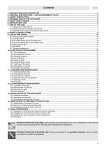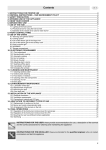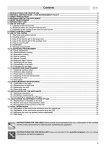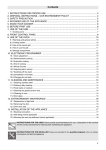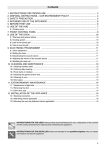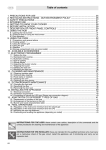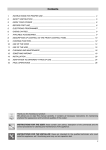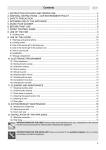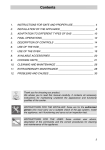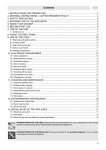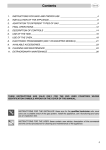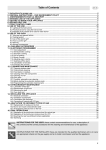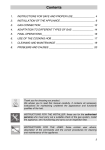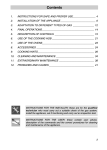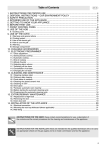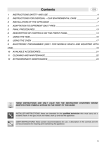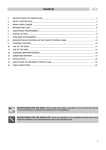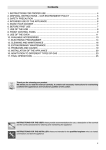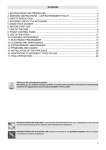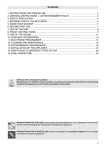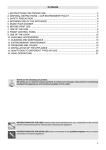Download Smeg SA92MFX5 Instructions for Use
Transcript
Contents 1. INSTRUCTIONS FOR PROPER USE ..................................................................................... 4 2. DISPOSAL INSTRUCTIONS – OUR ENVIRONMENT POLICY ............................................. 4 3. SAFETY PRECAUTION .......................................................................................................... 5 4. INTENDED USE OF THE APPLIANCE ................................................................................... 6 5. KNOW YOUR COOKER .......................................................................................................... 6 6. BEFORE FIRST USE .............................................................................................................. 6 7. USE OF THE HOB .................................................................................................................. 7 7.1 Lighting of the hob burners ............................................................................................................................. 7 7.2 Practical advice for using the hob burners ...................................................................................................... 7 7.3 Diameter of the vessels to be used on each burner ........................................................................................ 7 8. FRONT CONTROL PANEL ..................................................................................................... 8 9. USE OF THE OVENS ............................................................................................................ 10 9.1 Warnings and general advice ........................................................................................................................ 10 9.2 Cooling system .............................................................................................................................................. 10 9.3 Use of the electric grill in the large oven ....................................................................................................... 10 9.4 Use of the electric grill in the auxiliary oven .................................................................................................. 10 9.5 How to use the grill ........................................................................................................................................ 10 9.6 WARNING ..................................................................................................................................................... 11 9.7 Storage compartment .................................................................................................................................... 11 10. ELECTRONIC PROGRAMMER ......................................................................................... 12 10.1 Clock adjustment ......................................................................................................................................... 12 10.2 Semiautomatic cooking ............................................................................................................................... 12 10.3 Automatic cooking ....................................................................................................................................... 12 10.4 End of cooking ............................................................................................................................................ 12 10.5 Minute Counter ............................................................................................................................................ 13 10.6 Adjusting alarm volume ............................................................................................................................... 13 10.7 Switching off the alarm ................................................................................................................................ 13 10.8 Cancellation of set data ............................................................................................................................... 13 10.9 Changing the set data ................................................................................................................................. 13 11. CLEANING AND MAINTENANCE ....................................................................................... 14 11.1 Cleaning stainless steel .............................................................................................................................. 14 11.2 Ordinary daily cleaning ................................................................................................................................ 14 11.3 Food stains or residues ............................................................................................................................... 14 11.4 Cleaning of the hob components ................................................................................................................ 14 11.5 Cleaning of oven ......................................................................................................................................... 15 11.6 Door glass ................................................................................................................................................... 15 12. EXTRAORDINARY MAINTENANCE ................................................................................... 16 12.1 Lubrication of the taps ................................................................................................................................. 16 12.2 Replacement of light bulb ............................................................................................................................ 16 12.3 Removing the door ...................................................................................................................................... 16 12.4 Oven door seal ............................................................................................................................................ 16 13. INSTALLATION OF THE APPLIANCE ................................................................................ 17 13.1 Electrical connection ................................................................................................................................... 17 13.2 Gas connection ........................................................................................................................................... 18 13.3 Room ventilation ......................................................................................................................................... 19 13.4 Clearance above and around domestic cookers ......................................................................................... 19 14. ADAPTATION TO DIFFERENT TYPES OF GAS ............................................................... 21 14.1 Replacement of nozzles on the hob ............................................................................................................ 21 14.2 Burner and nozzle characteristics table ...................................................................................................... 22 14.3 Arrangement of the burners on the hob ...................................................................................................... 22 15. FINAL OPERATIONS .......................................................................................................... 23 15.1 Regulation of the hob burner minimum level for natural gas ....................................................................... 23 15.2 Regulation of the hob burner minimum level for ULPG ............................................................................... 23 15.3 Mounting the rear top skirtboard (where applicable) ................................................................................... 23 15.4 Wall fixing .................................................................................................................................................... 24 INSTRUCTIONS FOR THE USER: these provide recommendations for use, a description of the controls and the correct procedures for cleaning and maintaining the appliance INSTRUCTIONS FOR THE INSTALLER: these are intended for the qualified engineer who is to install, commission and test the appliance 3 Instructions for proper use 1. INSTRUCTIONS FOR PROPER USE THIS MANUAL IS AN INTEGRAL PART OF THE APPLIANCE AND THEREFORE MUST BE KEPT IN ITS ENTIRETY AND IN AN ACCESSIBLE PLACE FOR THE WHOLE WORKING LIFE OF THE COOKER. WE ADVISE READING THIS MANUAL AND ALL THE INSTRUCTIONS THEREIN BEFORE USING THE COOKER. ALSO KEEP THE SERIES OF NOZZLES SUPPLIED. INSTALLATION MUST BE CARRIED OUT BY QUALIFIED PERSONNEL IN ACCORDANCE WITH THE REGULATIONS IN FORCE. THIS APPLIANCE IS INTENDED FOR DOMESTIC USES AND CONFORMS TO CURRENT REGULATIONS IN FORCE. THE APPLIANCE HAS BEEN BUILT TO CARRY OUT THE FOLLOWING FUNCTIONS: COOKING AND HEATING-UP OF FOOD. ALL OTHER USES ARE CONSIDERED IMPROPER. THE MANUFACTURER DECLINES ALL RESPONSIBILITY FOR IMPROPER USE. NEVER USE THIS APPLIANCE FOR HEATING ROOMS. DO NOT LEAVE THE PACKING IN THE HOME ENVIRONMENT. SEPARATE THE VARIOUS WASTE MATERIALS AND TAKE THEM TO THE NEAREST SPECIAL GARBAGE COLLECTION CENTRE. REPLACED APPLIANCES MUST BE TAKEN TO A SPECIAL GARBAGE COLLECTION CENTRE. DO NOT OBSTRUCT VENTILATION OPENINGS AND HEAT DISPERSAL SLITS. THE I.D. PLATE WITH TECHNICAL DATA, REGISTRATION NUMBER AND BRAND NAME IS VISIBLY POSITIONED IN THE STORAGE COMPARTMENT. THE PLATE MUST NOT BE REMOVED. DO NOT USE METALLIC SPONGES OR SHARP SCRAPERS: THEY WILL DAMAGE THE SURFACE. USE NORMAL NON-ABRASIVE PRODUCTS FOR STEEL, AND A WOODEN OR PLASTIC TOOL IF NECESSARY. RINSE THOROUGHLY AND DRY WITH A SOFT CLOTH OR DEERSKIN. DO NOT ALLOW RESIDUES OF SUGARY FOODS (SUCH AS JAM) TO SET INSIDE THE OVEN. IF LEFT TO SET FOR TOO LONG, THEY MIGHT DAMAGE THE ENAMEL LINING OF THE OVEN. The manufacturer declines all responsibility for damage to persons or things caused by nonobservance of the above prescriptions or by interference with any part of the appliance or by the use of non-original spares. 2. DISPOSAL INSTRUCTIONS – OUR ENVIRONMENT POLICY Our appliances are only packaged using non-pollutant, environment-friendly, recyclable materials. We urge you to cooperate by disposing of the packaging properly. Contact your local dealer or the competent local organisations for the addresses of collection, recycling and disposal facilities. Never leave all or part of the packaging lying around. Packaging parts, and especially plastic bags, may represent a suffocation hazard for children. Your old appliance must also be disposed of properly. Important deliver the appliance to your local organisation authorised to collect scrapped appliances. Proper disposal allows the intelligent recovery of valuable materials. Refrigeration appliances contain gases which may damage the environment; it is important to ensure that the refrigeration circuit pipelines are not damaged until the competent service has taken delivery of the appliance. Before scrapping your appliances it is important to remove doors and leave shelves in position as for use, to ensure that children cannot accidentally become trapped inside during play. Also, cut the power supply lead and remove it and the plug. 4 Safety instruction 3. SAFETY PRECAUTION ELECTRICAL CONNECTION: PLEASE REFER TO INSTALLATION INSTRUCTION FOR THE GAS & ELECTRICAL SAFETY REGULATIONS AND THE VENTILATION REQUIREMENTS. IN YOUR OWN INTEREST, AND THAT OF SAFETY, IT IS THE LAW THAT ALL GAS APPLIANCES BE INSTALLED AND SERVICE BY COMPETENT PERSONS, WHO WILL COMPLY WITH THE RELEVANT STANDARDS AND REGULATIONS. CORGI REGISTERED INSTALLERS UNDERTAKE TO WORK TO SATISFCTIORY STANDARDS. DISCONNECTION OF GAS AND ELECTRIC APPLIANCES SHOULD ALWAYS BE CARRIED OUT BY COMPETENT PERSON. THE PLUG TO BE CONNECTED TO THE POWER CABLE AND THE SOCKET MUST BE THE SAME TYPE AND MUST CONFORM TO CURRENT REGULATIONS. THE SOCKET MUST BE ACCESSIBLE AFTER THE APPLIANCE HAS BEEN BUILT IN. NEVER UNPLUG BY PULLING ON THE CABLE. DO NOT INSTALL THIS APPLIANCE ON A RAISED PLATFORM. IT IS COMPULSORY THAT THE APPLIANCE BE GROUNDED ACCORDING TO THE METHODS REQUIRED BY SAFETY RULES. IMMEDIATELY AFTER INSTALLATION CARRY OUT A BRIEF INSPECTION TEST OF THE APPLIANCE, FOLLOWING THE INSTRUCTIONS BELOW. SHOULD THE APPLIANCE NOT FUNCTION, DISCONNECT IT FROM THE SUPPLY AND CALL THE NEAREST TECHNICAL ASSISTANCE CENTRE. NEVER ATTEMPT TO REPAIR THE APPLIANCE. DO NOT PUT PANS WITHOUT PERFECTLY SMOOTH AND FLAT BOTTOMS ON THE HOB GRIDS. DO NOT USE CONTAINERS OR BROILERS THAT EXTEND BEYOND THE OUTER PERIMETER OF THE HOB. NEVER PUT INFLAMMABLE OBJECTS IN THE OVEN: THEY COULD BE ACCIDENTALLY LIGHTED AND CAUSE FIRES. DURING USE THE APPLIANCE BECOMES VERY HOT. TAKE CARE NOT TO TOUCH THE HEATING ELEMENTS INSIDE THE OVEN. DO NOT SPRAY AEROSOLS IN THE VICINITY OF THIS APPLIANCE WHILE IT IS IN OPERATION. THE APPLIANCE IS DESIGNED FOR USE BY ADULTS. DO NOT ALLOW CHILDREN TO GO NEAR OR PLAY WITH IT. WHEN OPERATING THE GRILL ALL ACCESSIBLE PARTS COULD BECOME VERY HOT: KEEP OUT OF THE WAY OF CHILDREN. WHERE THIS APPLIANCE IS INSTALLED IN MARINE CRAFT OR IN CARAVANS, IT SHALL NOT BE USED AS A SPACE HEATER. WHEN NOT IN USE, MAKE SURE THAT THE CONTROL KNOBS ARE IN THE CORRECT (OFF) POSITION / . BEFORE THE APPLIANCE IS PUT INTO OPERATION, ALL THE LABELS AND PROTECTIVE FILMS APPLIED INSIDE OR OUTSIDE MUST BE REMOVED. 5 Instructions for the user 4. INTENDED USE OF THE APPLIANCE THE APPLIANCE HAS BEEN BUILT TO CARRY OUT THE FOLLOWING FUNCTIONS: COOKING AND HEATING-UP OF FOOD. ALL OTHER USES ARE CONSIDERED IMPROPER. The manufacturer declines all responsibility for damage to persons or things caused by nonobservance of the above prescriptions or by interference with any part of the appliance or by the use of non-original spares. 5. KNOW YOUR COOKER COOKING HOB CONTROL PANEL MAIN OVEN AUXILIARY OVEN STORAGE COMPARTMENT 6. BEFORE FIRST USE Do not leave the packing in the home environment. separate the various waste materials and take them to the nearest special garbage collection centre. The inside of the appliance should be cleaned to remove all manufacturing residues. For further information about cleaning, see section "11. CLEANING AND MAINTENANCE" Using the oven and the grill for the first time, heat them to the maximum temperature (260 or 245°C) for as long as it takes to burn off any production oil residues which could give a nasty flavour to the food. After a power cut, the oven display will flash intermittently and show "10. ELECTRONIC PROGRAMMER” 6 . To adjust refer to paragraph Instructions for the user 7. USE OF THE HOB 7.1 Lighting of the hob burners Before lighting the hob burners check that the flame caps are in the correct position and that their burner caps are in place, making sure that the holes A in the flame caps correspond to the spark plugs and thermocouples. The optional grid B is for use with “woks” (Chinese pans). To prevent deterioration of the hob we have equipped the cooker with a raised pan stand C to be placed underneath pans more than 26 cm in diameter. The supplied reduction rest C is used also for small pans. The drawing next to each knob shows the corresponding burner. The appliance has an electronic lighting device. Simply press and turn the knob anticlockwise to the minimum flame symbol , , until the flame is lit. Hold the knob down for a few seconds to allow the thermocouples to heat up. The burner may go out when the knob is released: this is because the thermocouple has not been sufficiently heated. Repeat the operation holding down the knob a little longer. This operation is not necessary for burners without thermocouples. For models with thermocouples, should the burner accidentally go out, a safety device will be activated which stops the gas flow even if the tap is open. 7.2 Practical advice for using the hob burners For better use of the burners and lower gas consumption, use covered vessel that are proportional in size to the burner to prevent the flame from licking the sides (see paragraph “ 7.3 Diameter of the vessels to be used on each burner”). When water reaches the boiling point, lower the flame so that it doesn’t overflow. To avoid burns or damage to the hob, all vessels or griddle plates must be placed within the perimeter of the hob. All vessels must have a flat and smooth bottom. When using fats or oils, be extremely careful that they don’t overheat and catch fire. If the flame accidentally goes out, turn off the control knob and wait at least 1 minute before trying to relight the burner. 7.3 Diameter of the vessels to be used on each burner BURNERS 1. Auxiliary 2. Semirapid 3. Rapid 4. Triple Crown Ø MIN. AND MAX. (IN CM.) 12 - 14 16 - 24 18 - 26 18 - 26 7 Instructions for the user 8. FRONT CONTROL PANEL All the cooker controls and commands are on the front panel. MAIN OVEN THERMOSTAT KNOB FRONT LEFT BURNER MAIN OVEN FUNCTION KNOB REAR LEFT BURNER AUXILIARY OVEN THERMOSTAT KNOB CENTRAL BURNER REAR RIGHT BURNER FRONT RIGHT BURNER If the cooker is equipped with an electronic programmer, before using the oven make sure that the symbol ; appears on the display. See paragraph “10. ELECTRONIC PROGRAMMER”. HOB BURNER COMMAND KNOB The flame is lit by pressing the knob and turning it anticlockwise to minimum flame . To adjust the flame turn the knob between maximum ( minimum ( ) and ). The burner goes out when the knob is returned to the position. MAIN OVEN THERMOSTAT KNOB Selection of cooking temperature is carried out by turning the knob clockwise to the required temperature, between 50° and 260°C. If the appliance has an electric oven, the warning light will come on when the oven is heating up. When it goes out it means that the required temperature has been reached. Regular flashing means that oven temperature is being constantly maintained at the programmed level. MAIN OVEN CONTROL KNOB Each of the functions listed below can be used (except the oven light and the small grill) only together with the correct temperature thermostat regulation as described on page of this manual. 8 Instructions for the user OVEN LIGHT GRILL ELEMENT + VENTILATION UPPER AND LOWER HEATING ELEMENT LOWER HEATING ELEMENT + VENTILATION GRILL ELEMENT VENTILATED HEATING ELEMENT + VENTILATION AUXILIARY OVEN THERMOSTAT KNOB Selection of cooking temperature is carried out by turning the knob clockwise to the required temperature, between 50° and 250°C. The tell-tale light comes on to indicate that the oven is warming up. When it goes out it means that the required temperature has been reached. Intermittent going on and off of the light means that oven temperature is being constantly maintained at the programmed level. The oven is switched on by turning the knob clockwise to any one of the following functions except the oven light: OVEN LIGHT GRILL ELEMENT UPPER AND LOWER HEATING ELEMENT 50 ÷ 245° UPPER HEATING ELEMENT AND GRILL ELEMENT LOWER HEATING ELEMENT 9 Instructions for the user 9. USE OF THE OVENS For the models with electronic programmer, before using the oven make sure that the display shows the symbol . 9.1 Warnings and general advice Using the oven and the grill for the first time, heat them to the maximum temperature (260-245°C) for as long as it takes to burn off any production oil residues which could give a nasty flavour to the food. After a power cut, the oven display will flash intermittently and show . To adjust refer to paragraph "10. ELECTRONIC PROGRAMMER ” Oven accessories which may come into contact with foods are made from materials complying with the requirements of the current directive. To prevent problems caused by steam in the oven, open the door in two stages: half open (5 cm approx.) for 4-5 seconds and then fully open. To access food, always leave the door open as short a time as possible to prevent the temperature in the oven from falling and ruining the food. 9.2 Cooling system The oven is equipped with a cooling system which automatically comes on upon a few minutes after the oven has been turned on. Fans cause a steady outflow of air from above the door which may continue for a brief period of time even after the oven has been turned off. 9.3 Use of the electric grill in the large oven For short cooking procedures, such as the final crisping of meat which is already cooked, select the static grill function and turn the thermostat knob to the maximum temperature. The fan grill function allows actual cooking procedures to be carried out, thanks to the fan function which ensures that the heat penetrates into the food. For this cooking mode, select the fan grill function (and turn the thermostat knob to the ideal cooking temperature (never set at more than 200° C). 9.4 Use of the electric grill in the auxiliary oven For short cooking procedures, such as the final crisping of meat which is already cooked, select the static grill function . 9.5 How to use the grill Once the grill is lit, the red warning light will come on. Leave the oven to heat up for five minutes before placing the food inside. Food should be flavoured and basted with oil or melted butter before cooking. An oven dish should be used to contain the sauces. The food should be placed on the oven shelf which is positioned on one of the guides supplied with the different ovens, following the instructions below: FOOD Flat or thin meat 10 GRILLE ON THE SHELF 3 Rolled roast joints 2-3 Poultry 2-3 Instructions for the user 9.6 WARNING • • • • • • • • Cooking procedures in this mode must never last more than 60 minutes. In models with gas oven, the door must be half-open on the first catch during grilling and grillrotisserie cooking. In models with electric oven, the door must be close during grilling and grill-rotisserie cooking. To avoid dangerous overheating when the oven or the grill is used, the glass cover must always be up. The electric grill and the gas oven cannot be used at the same time. During and after use the accessible parts of the oven may be very hot, and children must always be kept at a distance. During cooking with the rotisserie, one of the oven trays provided with the cooker should be placed in the bottom of the oven, inserting it on the bottom runners, in order to collect the grease andfatswhichmaybeformed. During cooking, do not cover the bottom of the oven with aluminium or tin foil and do not place pans or oven trays on it as this may damage the enamel coating. If you wish to use greaseproof paper, place it so that it will not interfere with the hot air circulation inside the oven. When using the oven, remove all unused baking sheets and shelves from the interior. 9.7 Storage compartment A storage compartment, accessible by pulling on the top edge of the door, is located beneath the oven. Never store flammable materials such as rags, paper or the like. The compartment is intended only for holding the metal accessories of the range. Never open the storage compartment when the oven is on and still hot. The temperature inside may be very high. 11 Instructions for the user 10.ELECTRONIC PROGRAMMER The programmer user instructions are valid only for the main oven. LIST OF FUNCTIONS MINUTE-COUNTER KEY COOKING TIME KEY END OF COOKING KEY DECREASE TIME KEY INCREASE TIME KEY 10.1 Clock adjustment When using the oven for the first time, or after a power failure, the display flashes regularly and indicates . Press the keys and and at the same time the keys or : each single press changes the time by 1 minute either up or down. Before setting the programmer activate the desired function and temperature. 10.2 Semiautomatic cooking Use this setting for automatic oven switch-off at the end of cooking time. By pressing key the display lights up, showing ; keep the key pressed and at the same time, press keys or to set the cooking time. Release key to start the programmed cooking time count. The display will now show the right time together with symbols A and . 10.3 Automatic cooking Use this setting to automatically start and stop the oven. By pressing key the display lights up showing ; keep the key pressed and at the same time, press keys or to set the cooking time. By pressing key the sum of the right time + cooking time will appear; keep the key pressed and at the same time, press keys or regulate the end of cooking time. Release key to start the programmed count and the display will show the right time together with symbols A and . After set-up, to see the cooking time remaining, press the key ; to see the end of cooking time press the key .Set-up with incoherent values is logically prevented (e.g. the contrast between a cooking time and a longer period will not be accepted by the programmer). 10.4 End of cooking When cooking is over, the oven will automatically switch off and, at the same time, an intermittent alarm will sound. After switching off the alarm, the display will once again show the right time together with the symbol , indicating that the oven has returned to manual operation mode. 12 Instructions for the user 10.5 Minute Counter The programmer can also be used as a simple minute counter. By pressing key the display shows ; keep the key pressed and at the same time press keys or . On releasing the key programmed counting will begin and the display will show the current time and the symbol. After set-up, to see the remaining time, press the key . Use as a minute counter does not interrupt functioning of the oven at the end of the programmed time. 10.6 Adjusting alarm volume The acoustic alarm has three different settings. These can be operated, while the alarm is sounding, by pressing key . 10.7 Switching off the alarm The alarm switches off automatically after seven minutes. They can be manually de-activated by pressing the keys and . together. To switch off the appliance, rotate all the knobs to position 0. 10.8 Cancellation of set data Once the programme has been set, keep the key of the function to be cancelled pressed, while at the same time is reached by means of variation keys or . Time cancellation will be considered as end-of-cooking time by the programmer. 10.9 Changing the set data The cooking data entered can be changed at any time by keeping the function key pressed and at the same time adjusting the keys or . 13 Instructions for the user 11.CLEANING AND MAINTENANCE NEVER USE A STEAM JET TO CLEAN THE APPLIANCE. 11.1 Cleaning stainless steel To maintain stainless steel in good condition clean it regularly after each use, once it has cooled down. 11.2 Ordinary daily cleaning To clean and preserve the stainless steel surfaces, always use only specific products that do not contain abrasives or chlorine-based acids. How to use: pour the product on a damp cloth and wipe the surface, rinse thoroughly and dry with a soft cloth or deerskin. 11.3 Food stains or residues Do not use metallic sponges or sharp scrapers: they will damage the surface. Use normal non-abrasive products for steel, and a wooden or plastic tool if necessary. Rinse thoroughly and dry with a soft cloth or deerskin. Do not allow residues of sugary foods (such as jam) to set inside the oven. If left to set for too long, they might damage the enamel lining of the oven. 11.4 Cleaning of the hob components 11.4.1Grids Remove the grids and clean them in warm water with a non-abrasive detergent, taking care to remove any encrustations. Replace them on the hob. Continuous contact of the grids with the flame can cause the enamel near the hot areas to be altered. This is completely natural and does not compromise the functionality of the component. 11.4.2Burner caps and flame cap crowns The caps and flame-spreader crowns are extractable to facilitate cleaning. Wash them in hot water with non-abrasive detergent, taking care to remove any encrustations, and wait until they are perfectly dry. WARNING: do not wash these components in the dishwasher. The burners can be left to soak in hot water and detergent. Replace the flame-spreader crowns, checking that they are positioned in their housing with their respective caps, taking care that flame-spreader holes A correspond to the spark plugs and the thermocouples. 11.4.3The spark plugs and thermocouples To function properly the spark plugs and thermocouples must always be clean (on the models which are equipped with them). Check them regularly and clean with a damp cloth if necessary. Any dry residues can be removed with a toothpick or a needle. 14 Instructions for the user 11.5 Cleaning of oven For best oven upkeep clean regularly after having allowed to cool. Take out all removable parts. • • Clean the oven grill with hot water and non-abrasive detergent. Rinse and dry. Do not allow residues of sugary foods (such as jam) to set inside the oven. If left to set for too long, they might damage the enamel lining of the oven. 11.6 Door glass The door glass should always be kept clean. Use absorbent kitchen paper to clean. In case of tough spots, clean with a damp sponge using regular detergent. When cleaning, the appliance must be dried thoroughly since detergent and water drips might damage its operation and appearance. 15 Instructions for the user 12.EXTRAORDINARY MAINTENANCE The oven may require extraordinary maintenance or replacement of parts subject to wear such as seals, bulbs, and so on. The following instructions describe how to carry out these minor maintenance operations. Before any intervention, disconnect the power supply of the device. 12.1 Lubrication of the taps In time the taps may be difficult to turn or may be blocked. Clean them inside and replace the lubrication grease. This operation should be carried out by a specialised technician. 12.2 Replacement of light bulb Remove cover A by twisting anticlockwise, replace bulb B with another similar bulb (25 W). Refit the cover A. Only use oven bulbs (T 300°C). 12.3 Removing the door Hold the door on both sides with both hands near hinges A and raise levers B. Lift up the door forming an angle of about 45° and remove. To refit, slide the hinges A in the grooves, drop the door and release levers B. 12.4 Oven door seal To permit thorough cleaning of the oven, the seal may be removed. Before removing the seal, take off the door as described above. Once the door has been taken off, lift the tabs at the corners as shown in the figure. 16 Instructions for the installer 13.INSTALLATION OF THE APPLIANCE It is the law that all gas appliances are installed by authorised persons. Clearance around the cooker must comply with the requirements of AS5601. 13.1 Electrical connection Make sure that the power line voltage matches the specifications indicated on the rating plate located inside the storage compartment. This rating plate must never be removed. On the power line, install a two-pole cut-off device with contact cut-off distance greater than or equal to 3 mm, located in an easily accessible position near the unit. The connection terminals are located at the rear of the appliance. For electrical connections see following diagram. To access, remove the rear cover. For operation on 380-415V3N (only for 90 cm models): use an H05RR-F / H05RN-F / H05V2V2-F type five-core cable (5 x 1.5 mm2). For operation on 380-415V2N (only for 90 cm models): use an H05RR-F / H05RN-F / H05V2V2-F type five-core cable (cavo di 4 x 1.5 mm2) For operation on 220-240V : use an H05RR-F / H05RN-F / H05V2V2-F (3 x 2.5 mm2). The cable end to be connected to the appliance must be provided with an ground wire (yellow-green) at least 20 mm longer. The manufacturer declines all responsibility for damage to persons or things caused by nonobservance of the above prescriptions. 17 Instructions for the installer Overall dimensions: location of gas and electrical connection points (all measures in mm). A B C D 60 410 60 70 13.2 Gas connection This appliance is suitable for installation with Natural Gas or ULPG (propane). Refer to page 12 for the relevant burner pressure and appropriate injector sizes. When the appliance is to be connected to Natural Gas then the pressure regulator supplied must be fitted to the gas inlet. A test point (for checking the gas pressure) is supplied either with the regulator or as a separate fitting in the case of ULPG (propane) appliances. Connection of the appliance to the gas supply must be in accordance with the requirements of AS5601. A ½” BSP connector at the inlet is recommended and the gas supply line to the appliance must be of adequate length to allow sufficient withdrawal of appliance for service or disconnection and be annealed copper pipe. The cooker must be installed with provision to allow the gas to be turned off and disconnected for servicing and removal of the appliance as required from the gas supply. Before the cooker is operated make certain all relevant parts are placed in the correct position. When the installation is completed the installation connections of cooker will require to be leak tested, the burner operating pressure and flame checked and adjusted. Warranty service calls do not cover these adjustments! To check the operating pressure of the appliance it is recommended at least 2 large size burners are used. Ensure appliance is secured to wall when installation is completed. N.G. The regulator supplied must be fitted to the ½ BSP thread at the rear of the appliance. An approved manual shut-off valve must be installed. The N.G. regulator must be checked and adjusted to 1.0 kPa after installation. L.P.G. Can be connected to the inlet fitting directly. The pressure must be checked to ensure it is operating at 2.75 kPa. A separate test point fitting must be installed between the piping & the appliance for the pressure to be checked to ensure it is operating at 2.75 kPa. 18 Instructions for the installer 13.3 Room ventilation Caution – This cooker may only be installed and operated in rooms permanently ventilated in accordance with current regulations. For proper operation of a gas appliance it is essential for the air necessary for combustion of the gas to be able to flow naturally into the room. Air must flow directly into the room through openings in its outside walls. This (these) opening (s) must have a free passage cross-section of at least 100 cm 2, or 200 cm 2 for appliances not equipped with gas safety device. These openings must be constructed so that they cannot be obstructed indoors or outdoors, and should preferably be close to the floor on the side opposite to the combustion gas discharge point. If it is not possible to make the openings in the room where the cooker is installed, the necessary air may be taken from an adjoining room, proveded it is not a bedroom or a room with fire risk. 13.4 Clearance above and around domestic cookers Extract from AS5601 19 Instructions for the installer REQUIREMENTS 1 Overhead clearances – (Measurement A) Range hoods and exhaust fans shall be installed in accordance with the manufacturer’s instructions. However, in no case shall the clearance between the highest part of the hob of the cooking appliance and a range hood be less than 600 mm or, for an overhead exhaust fan, 750 mm. Any other downward facing combustible surface less than 600 mm above the highest part of the hob shall be protected for the full width and depth of the cooking surface area in accordance with Clause 5.12.1.2. However, in no case shall this clearance to any surface be less than 450 mm. 2 Side clearances – (Measurements B & C) Where B, measured from the periphery of the nearest burner to any vertical combustible surface,is less than 200 mm, the surface shall be protected in accordance with Clause 5.12.1.2 to a height C of not less than 150 mm above the hob for the full dimension (width or depth) of the cooking surface area. Where the cooking appliance is fitted with a ‘splashback’, protection of the rear wall is not required. 3 Additional requirements for Freestanding and Elevated Cooking Appliaces – (Measurements D & E) Where D, the distance from the periphery of the nearest burner to a horizontal combustible surface is less than 200 mm,then E shall be 10 mm or more, or the horizontal surface shall be above the trivet. See insets above. NOTES 1 Requirement 3 does not apply to a freestanding or elevated cooking appliance which is designed to prevent flames or the cooking vessels from extending beyond the periphery of the appliance. 2 The ‘cooking surface area’ is defined as that part of the appliance where cooking normally takes place and does not include those parts of the appliance containing control knobs. 3 For definition of hob, see Clause 1.4.64. 4 For definition of trivet, see Clause 1.4.109. 5 Consideration is to be given to window treatments when located near cooking appliances. See Clause 5.3.4. 20 Instructions for the installer 14.ADAPTATION TO DIFFERENT TYPES OF GAS Before performing any cleaning or maintenance work, disconnect the appliance from the mains. The hob of the cooker is adjusted for use with natural gas at a pressure of 1.0kPa. If used with other types of gas, you have to replace the nozzles and regulate the primary air to the burners. Then adjust the minimum flame on the gas taps. For nozzle replacement and burner adjustment you must raise the hob as described in the following paragraph. 14.1 Replacement of nozzles on the hob 1 Extract the grids and remove all the caps and flame-spreader crowns; 2 Unscrew the burner nozzles with a 7 mm socket wrench; 3 Replace the nozzles according to the type of gas to be used and the description in paragraph "14.2 Burner and nozzle characteristics table "; 4 Replace the burners in the correct position. 21 Instructions for the installer 14.2 Burner and nozzle characteristics table Burner ULPG (PROPANE) – 2.75 kPa Auxiliary Semi rapid Rapid Triple crown Nominal gas consumption (MJ/h) 3.9 6.3 10.0 12.8 Burner Turn-down gas consumption (MJ/h) 1.5 1.5 2.7 5.4 Injector (mm) 0.54 0.68 0.88 1.00 NG – 1.0 kPa Auxiliary Semi rapid Rapid Triple crown Nominal gas consumption (MJ/h) 3.9 6.5 12 15 Turn-down gas consumption (MJ/h) 1.5 1.5 2.7 5.4 Injector (mm) 0.90 1.20 1.55 1.75 14.3 Arrangement of the burners on the hob 22 BURNERS ø min e max (in cm.) 1 Auxiliary 12 - 14 2 Semi rapid 16 - 24 3 Rapid 18 - 26 4 Triple crown 18 - 26 Instructions for the installer 15.FINAL OPERATIONS After replacing the nozzles, reposition the flame-spreader crowns, the burner caps and the grids. Following adjustment to a gas other than the preset one, replace the gas adjustment label fixed to the appliance with the one corresponding to the new gas. This label is in the packet together with the nozzles. 15.1 Regulation of the hob burner minimum level for natural gas Light the burner and turn it to the minimum position . Extract the gas tap knob and turn the adjustment screw at the side of the tap rod until the correct minimum flame is achieved. Replace the knob and check burner flame stability: (rapidly turning the knob from maximum to minimum position, the flame should not go out). Repeat the operation on all the gas taps. For models with valves, keep the knob at minimum level for about 1 minute to keep the flame lit and to activate the safety device. 15.2 Regulation of the hob burner minimum level for ULPG In order to adjust the minimum with ULPG, the screw at the side of the tap rod must be turned clockwise all the way. The bypass diameters for each individual burner are shown in paragraph “14.2 Burner and nozzle characteristics table". Once the regulation has been completed, restore the seal on the by-passes using paint or similar materials. 15.3 Mounting the rear top skirtboard (where applicable) • • • Loosen nuts B. Position the skirt above the top, taking care to align pins C with holes D. Secure the skirt to the top by tightening screws A. 23 Instructions for the installer 15.4 Wall fixing In order to prevent accidentaltipping of the appliance, for example by a child climbing onto the open oven door, a stabilizing means must be installed. Please refer to instructions for installation. • • • • 24 Stretch out the chain attached to the cooker horizontally so that the other end touches the wall. Mark the wall in the position where the hole is to be drilled. Drill the hole, insert a wall plug and attach the chain. Move the cooker up against the wall. 914773014/ B
























